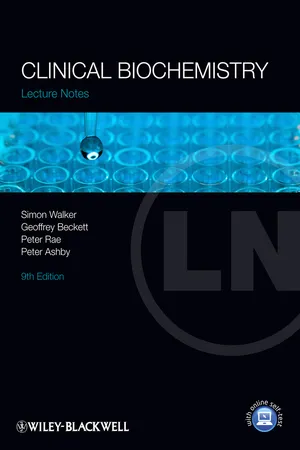
- English
- ePUB (mobile friendly)
- Available on iOS & Android
Clinical Biochemistry
About This Book
Concise yet comprehensive, Clinical Biochemistry Lecture Notes contains all the essential information for students and foundation doctors to understand the biochemical basis of disease and principles of biochemical diagnostics. It presents scientific principles in a clinical setting, with a range of case studies integrated into the text to clearly demonstrate how knowledge should be applied to real-life situations. Key features include:
•The fundamental science underpinning common biochemical disorders and their investigation in clinical practice
•Accessible flow charts of biochemical processes and the reasoning behind specific tests, making look-up and understanding easy
•A brand new companion website at www.lecturenoteseries.com/clinicalbiochemistry withself-assessment and downloadable summary slides for revision
Clinical Biochemistry Lecture Notes is an ideal overview and revision guide for medical students, foundation doctors, general practitioners, and nurses. It also provides a core text for scientific and medical staff pursuing a career in clinical biochemistry.
Frequently asked questions
Information


- Pre-analytical. These arise prior to the actual test measurement and can happen at the clinical or laboratory end. Most errors fall into this category (see Table 1.1).
- Analytical. Laboratory based analytical errors are rare but may occur e.g. reagent contamination, pipetting errors related to small sample volumes, computing errors.
- Post-analytical. These are increasingly rare because of electronic download of results from the analyser but include, for example, transcription errors when entering results from another laboratory into the computer manually; results misheard when these are telephoned to the clinician.
| Error | Consequence |
| Crossover of addressograph labels between patients | This can lead to two patients each with the other's set of results. |
| Where the patient is assigned a completely wrong set of results, it is important to investigate the problem in case there is a second patient with a corresponding wrong set of results. | |
| Timing error | There are many examples where timing is important but not considered. Sending in a blood sample too early after the administration of a drug can lead to misleadingly high values in therapeutic monitoring. Interpretation of some tests (e.g. cortisol) is critically dependent on the time of day when the blood was sampled. |
| Sample collection tube error | For some tests the nature of the collection tube is critical, which is why the Biochemistry Laboratory specifies this detail. For example, using a plasma tube with lithium–heparin as the anti-coagulant invalidates this sample tube for measurement of a therapeutic lithium level! Electrophoresis requires a serum sample; otherwise, the fibrinogen interferes with the detection of any monoclonal bands. Topping up a biochemistry tube with a haematology (potassium ethylenediamine tetraacetic acid (EDTA) sample) will lead to high potassium and low calcium values in the biochemistry sample. |
| Sample taken from close to the site of an intravenous (IV) infusion | The blood sample will be diluted so that all the tests will be correspondingly low with the exception of those tests that might reflect the composition of the infusion fluid itself. For example, using normal saline as the infusing fluid would lead to a lowering of all test results, but with sodium and chloride results that are likely to be raised. |
Table of contents
- Cover
- Series Info
- Title Page
- Copyright
- Preface
- List of abbreviations
- How to use your textbook
- About the companion website
- Chapter 1: Requesting and interpreting tests
- Chapter 2: Disturbances of water, sodium and potassium balance
- Chapter 3: Acid–base balance and oxygen transport
- Chapter 4: Renal disease
- Chapter 5: Disorders of calcium, phosphate and magnesium metabolism
- Chapter 6: Diabetes mellitus and hypoglycaemia
- Chapter 7: Disorders of the hypothalamus and pituitary
- Chapter 8: Abnormalities of thyroid function
- Chapter 9: Disorders of the adrenal cortex and medulla
- Chapter 10: Investigation of gonadal function infertility, menstrual irregularities and hirsutism
- Chapter 11: Pregnancy and antenatal screening
- Chapter 12: Cardiovascular disorders
- Chapter 13: Liver disease
- Chapter 14: Gastrointestinal tract disease
- Chapter 15: Nutrition
- Chapter 16: Trauma, inflammation, immunity and malignancy
- Chapter 17: Disorders of iron and porphyrin metabolism
- Chapter 18: Uric acid, gout and purine metabolism
- Chapter 19: Central nervous system and cerebrospinal fluid
- Chapter 20: Therapeutic drug monitoring and chemical toxicology
- Chapter 21: Clinical biochemistry in paediatrics and the elderly
- Index